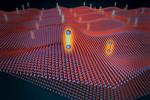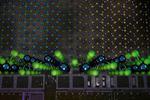Other

“Researchers have used a technique similar to MRI to follow the movement of individual atoms in real time as they cluster together to form two-dimensional materials, which are a single atomic layer thick. The results, reported in the journal Physical …

“Researchers at The University of Manchester’s National Graphene Institute have created optical devices with a unique range of tunability, covering the entire electromagnetic spectrum, including visible light. A paper published in Nature Photonics outlines applications for this ‘smart surface …

“Scientists from the Skoltech Center for Energy Science and Technology (CEST) have developed a method for modelling the behavior of 2D materials under pressure. The research will help create pressure sensors based on silicene or other 2D materials. The paper …
“Metal-insulator transition (MIT) driven by many-body interactions is an important phenomenon in condensed matter physics. Exotic phases always emerge around the metal-insulator transition points where quantum fluctuations arise from a competition among spin, charge, orbital, and lattice degrees of freedom …

“2D materials have triggered a boom in materials research. Now it turns out that exciting effects occur when two such layered materials are stacked and slightly twisted. The discovery of the material graphene, which consists of only one layer of …

“A new kind of two-dimensional (2D) material with unique properties has been discovered by researchers with The University of Texas at Austin, bringing next-generation flexible electronic devices one step closer. In materials science, size matters. And currently 2D materials are …

“The National Physical Laboratory (NPL), in collaboration with international partners, have developed an ISO/IEC standard, ISO/TS 21356-1:2021, for measuring the structural properties of graphene, typically sold as powders or in a liquid dispersion. The ISO/IEC standard …

“Paragraf, the leader in graphene-based transformative electronic devices, announces a new graphene Hall Effect sensor ideally suited to battery applications, such as the electric vehicle (EV) sector. The graphene GHS01AT Hall Effect sensor is optimised for use in relatively low …

“Until now, hexagonal boron nitride was considered the insulator of choice for miniaturised transistors. New investigations by TU Wien (Vienna) show: this may not be the way to go. For decades, there has been a trend in microelectronics towards ever …

“Borophane is stable outside a vacuum, opening possibilities for real-world applications. Northwestern Engineering researchers have, for the first time, created borophane — atomically thin boron that is stable at standard temperatures and air pressures. Researchers have long been excited by the …
